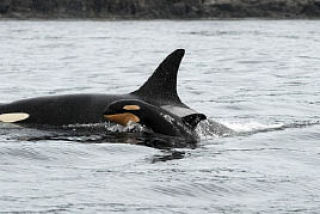The Center for Whale Research (CWR) discovered a new killer whale calf, in the family group that researchers call the L Pod, on Aug. 12. When the mother, L47, who is also known as Marina, was observed on the evening of Aug. 11 there was no calf present, which leads staff to believe the calf was less than 24 hours old when first spotted. From the calf’s size, the appearance of fetal folds and the presence of the umbilical cord, it is likely the calf was actually only a few hours old when first photographed by CWR staff. The new calf, which was named or designated L111, was confirmed to be female on Aug. 15.
“This particular pod has potentially lost three of its members this year. The losses are not confirmed but are suspicious. The birth of this new calf is a very positive thing,” says Erin Heydenreich, CWR Senior Staff Assistant. “The new calf’s siblings have been very interested in her, especially the females of reproductive age. We have observed them pushing and rolling the new calf in a playful way,” she said. “The social bonds in the southern salmon-eating killer whales are very strong. This new calf will travel with her mother’s family group for her entire life. Since whales do not mate within their own pods, we assume that the father is from either the J or K Pod family units.”
According to CWR research, individual whales live their entire life in the family group in which they are born. “The bonds among females and their offspring are extremely strong and persist throughout the whale’s life. All ages and both sexes of whales tend to spend the greatest proportions of their time traveling with their mothers. It is this long-term relationship between mothers and young that is the most significant feature of resident societies, and it accounts for the kinds of social structures that we see in the population. Resident killer whales live in groups that are organized along lines of maternal relatedness. Each whale belongs to a matrilineal genealogy, that is, a family tree showing an individual’s ancestry through his mother and her relatives.” The matriarch of L pod is L-25, also known as Ocean Sun, born in 1928.
L111 is the sixth calf born to L47, who at 34 is also a grandmother. L47’s last calf was born in the summer of 2005 and died after a few months. She has two other surviving offspring. The CWR has tracked and photographed local orca populations since 1976. Their website states that the birth of L111 is an important event in the L pod which as of December 2007 was comprised of 43 whales. “If L111 returns to the San Juan Islands next summer, it will be officially counted in the population,” according to CWR.
Additional photos of L111, the rest of the L Pod and J and F Pod members can be found at the CWR website at www.whaleresearch.com.



